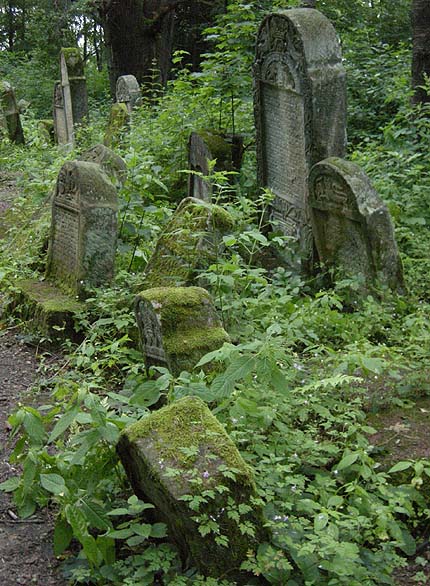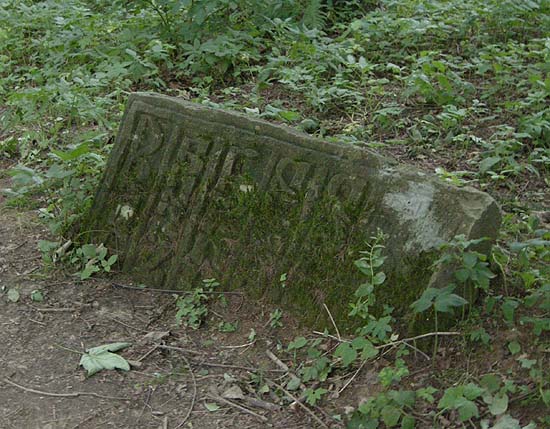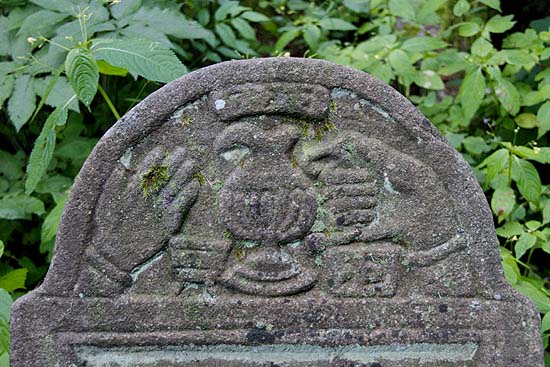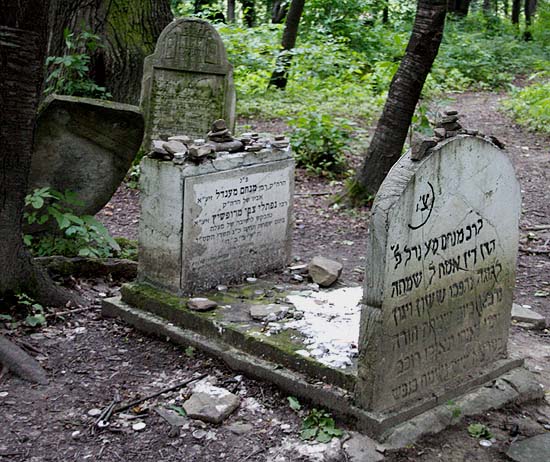The Jewish cemetery of Lesko lays to the north of the Sephardic synagogue, on the top of a high hill. It is said to be one of the largest Jewish cemeteries of Poland where even after the destructions of 1942 more than two thousand tombs remained intact. Now they are being destroyed by the time. The largest part of the cemetery – except for the entrance with the grave ofthe martyrs of Belżec and a clearing somewhere in the middle with the graves of the rabbis of Lesko still attracting visitors from far and wide – are covered with weed, the stones sink into the earth, moss and fungi make illegible their inscriptions and disintegrate their carvings. It seems that the inhabitants of modern Lesko are not interested in the conservation of this heritage. It is sad to see this decay, but if we compare it to the Disneyland into which the old ghetto of Cracow has been recently transformed, this place still appears much more genuine.
Right after entering the gate, we encounter the oldest tombs of the cemetery. According to the testimonies of their inscriptions they are not much younger than the Jewish community of Lesko itself whose origins reach back to the beginning of the 16th century. The oldest tomb I could decipher was dated of 1599.
The last line of the inscription includes the Hebrew date 5359 corresponding to the year of 1599
These early tombstones lack any imagery, but the calligraphy of the inscriptions is exceptionally beautiful. Although the community of Lesko was founded by Sephardic Jews, the impact of the Ashkenazi cultural environment may have been quite strong, as these stones – in contrast to the traditionally laying Sephardic tombstones – are standing erect, and most of them display an Ashkenazi calligraphy of a classical beauty. The inscriptions are rather laconic: the name of the deceased and the date of the death are framed only by the traditional formulas “Here is hidden” and “May his/her soul be bound up into the bundle of life”.
Beginning with the end of the 17th century, the decoration of the stones gets richer. There appear the first symbols indicating the descent and conditions of the deceased. The tombs of the Kohanim – the descendants of high priest Aaron – are marked by two hands lifted to priestly blessing.
In the times of the Temple of Jerusalem, the helpers of the high priests belonged to the tribe of Levi. Similarly to the Kohanim, they also keep in evidence their descent. Their tombs are decorated with the pitcher with which they had washed the hands of the high priest in the Sanctuary.
This tomb of a Levite from a good family has the inscription “Estimated man from the Horowitz family”. Above the pitcher on the top of the stone there is a three-letters Hebrew word pronounced as “Segal”. This is the widespread abbreviation of the title of the Levites: “Segan leviyyah” whose interpretation is debated. Literally it means “the Levitical deputy”, but it is better translated as “the prince of the Levites” or “the assistant of the high priest”. It is first used in a written document for the indication of the Levites in 1070. Later it became a frequent family name for Levites; the renowned painter Mark Chagall also bears a version of this name in a French transcription.
The tombs of housewives are often decorated with five-branched candlesticks referring to the festive candle-lighting and to the piety of the deceased woman. In the cemetery of Lesko this symbol is found in a fantastic diversity: there are candlesticks with three, five and seven branches in a variety of styles from a flamboyant Baroque to a Classic sobriety.
In the 18th and 19th century the art of tombstones lived a great revival. This period saw the establishment of an Eastern European school of tombstone carving which assimilated the motifs of high Baroque art into a “folk Baroque”, a widespread popular art. This virtually unprecedented flaring of folk art was most certainly connected with the incursion of Hassidism which propagated the beauty and love of life, and rediscovered the relationship between man and nature. This unexpected outburst of joy of life is reflected in the new Jewish folk art of the 18th century which penetrated dance, music, illustrations and pottery as well as the work of tombstone carvers. The stones of this period display a never seen proliferation of pictorial symbols and decorations. Often it is impossible to determine whether a certain element of the rich decoration – an animal as an eagle, deer, lion or dove, or a crown, a bookcase, a fruit or a flower – is a symbol or just an ornament. It is perhaps more correct to speak about an imagery or a pictorial language which recalled a series of associations in the pious Jews well-versed in the Bible and the Talmud. To mention just an example, several Jewish tombstones display a cluster of grapes. According to the great professor of Jewish folklore, Rabbi Sándor Scheiber this symbolizes the family: “Your wife is like a fertile grapevine” (Ps 128:3), while in other places it is the symbol of Israel: “You have torn out a grapevine from Egypt” (Ps 80:9). Which one is the right meaning? What did the one-time master want to convey with this symbol? A large number of interpretations is possible, and this makes the message of the stones attractive and beautiful.
Let us highlight some recurrent tombstone motifs together with their Biblical and Talmudic sources. We often see a crown on the top of the stone. This refers to a verse of the Talmudic tractate Pirkei Avot: “There are three crowns: the crown of the Torah, the crown of priesthood, and the crown of kingship, but the crown of a good name surpasses them all.” (Avot 4:17)
For full article and additional pictures - http://riowang.blogspot.com/2010/08/lesko-jewish-cemetery.html
Tags:
Replies to This Discussion
-
Permalink Reply by Mystic Wolf on April 3, 2016 at 11:53am
-
Wow, the cemetery is remarkable for its age.
-
Have questions?
Need help? Visit our Support Group for help from our friendly Admins and members!
Have you?
Donations & Sponsorship
Connect
Visit The Temple
on Facebook:
Blog Posts
Channeled Angelic Wisdom of the Jewels of Truth Series on Meta-Divine Creation & The Meta-Nexus Reality Threshold
Posted by Atrayo on July 25, 2024 at 7:38pm 0 Comments 2 Likes
RA!
Posted by Rosey Cross on July 21, 2024 at 5:21pm 0 Comments 0 Likes
WE!
Posted by Rosey Cross on July 20, 2024 at 6:20pm 0 Comments 0 Likes
TWIN FLAME PASSION!
Posted by Rosey Cross on July 18, 2024 at 6:44pm 0 Comments 0 Likes
THE DAUGHTER
Posted by Rosey Cross on July 15, 2024 at 6:40pm 0 Comments 0 Likes
THE ANSWER
Posted by Rosey Cross on July 10, 2024 at 6:57pm 0 Comments 0 Likes
THE CALL
Posted by Rosey Cross on July 5, 2024 at 2:15pm 2 Comments 2 Likes
THE REPORT OF THE DRAGON!
Posted by Rosey Cross on July 5, 2024 at 1:52pm 2 Comments 1 Like
THE LESSON OF SHE
Posted by Rosey Cross on July 2, 2024 at 3:22pm 0 Comments 0 Likes
EVENTS I SEE
Posted by Rosey Cross on June 28, 2024 at 5:42pm 0 Comments 0 Likes
Channeled Angelic Wisdom of the Jewels of Truth Series on Rainbows and Being
Posted by Atrayo on June 2, 2024 at 3:19pm 0 Comments 1 Like
Joke Corner
Posted by William J. Coblentz on May 30, 2024 at 5:57pm 9 Comments 9 Likes
Channeled Angelic Wisdom of the Jewels of Truth Series on Conduct, Being, and Personal Character
Posted by Atrayo on May 30, 2024 at 2:55pm 0 Comments 1 Like
Is Consciousness Energy Based?
Posted by Bill Walker on May 9, 2024 at 10:00pm 2 Comments 2 Likes
Channeled Angelic Wisdom of the Jewels of Truth Series on Beneficence and Heaven on Earth
Posted by Atrayo on April 17, 2024 at 10:26am 0 Comments 1 Like
Channeled Angelic Wisdom of the Jewels of Truth Series on Unconditional Truth and Free Will
Posted by Atrayo on April 14, 2024 at 7:54am 0 Comments 1 Like
Channeled Angelic Wisdom of the Jewels of Truth Series on The Afterlife, God, & World Peace
Posted by Atrayo on April 6, 2024 at 1:51pm 0 Comments 1 Like
coat of arms of McIntyre clan.
Posted by Ghillie Dhu on March 2, 2024 at 5:06am 4 Comments 0 Likes
Channeled Angelic Wisdom of the Jewels of Truth Series on Destiny, Future Past, and Meta-Genesis
Posted by Atrayo on February 22, 2024 at 12:54am 0 Comments 1 Like
NOVEMBER AWARENESS
Videos
-
Two Become One
Added by Imelda James 0 Comments 0 Likes
-
You and I Love
Added by Imelda James 0 Comments 0 Likes
-
Deuce - America
Added by Bryan_Thoth 0 Comments 0 Likes
© 2024 Created by Bryan
Powered by
![]()











